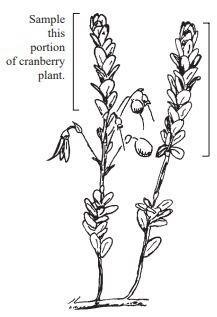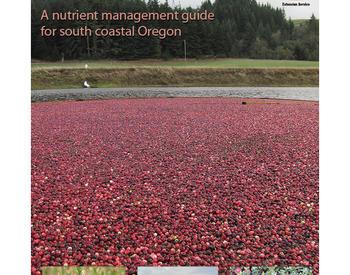Why use tissue testing?
Cranberry plants require proper amounts of certain chemical elements from air, water, and soil to ensure adequate vegetative growth and fruit production. When levels of these nutrients in the plant are low, growth and yield may be affected.
Severely reduced nutrient supply can lead to visible nutrient deficiency symptoms. Routine collection and analysis of tissue samples can detect low nutrient concentration before visible symptoms or yield reduction occurs.
Mineral nutrients such as nitrogen (N), phosphorus (P) and potassium (K) are added through fertilizers to supplement the supply from the soil. By analyzing dried plant tissues for their nutrient content (tissue testing), you can evaluate the adequacy of mineral nutrients. This information will help you decide if fertilizer is needed, and if so, how much and what kind to use.
Tissue testing can be used for any of the following:
- Predicting fertilizer needs of annual crops.
- Diagnosing problems.
- Evaluating a fertilizer program for perennial crops.
Tissue testing can be used to monitor and adjust fertilizer use during early growth stages of annual crops such as potatoes, sugar beets or lettuce. By using a tissue test, growers can anticipate fertilizer needs for these annual crops.
In contrast, using tissue test results to anticipate current-season fertilizer needs does not work well for perennial crops like cranberries. In part, this is due to the minimal short-term effect of fertilizer on yield in perennial crops. Therefore, tissue testing in producing cranberries is best used for end-of-season evaluation of a fertilizer program for the next year.
Of course, overuse of fertilizer, particularly of nitrogen, can have negative short-term effects. These include stimulation of excessive vine growth and fruit rot.
If problems such as poor growth or discoloration of vines appear during the growing season, you can use a comparative tissue test to check for possible nutrient deficiencies. You can collect samples to diagnose deficiencies at any time during the season. However, when outside the August–September time period (see “When to sample” below), you also must collect a companion sample from an unaffected area for comparison.
Before using tissue testing to predict or evaluate fertilizer needs, you need the following information, which is provided in this publication:
- Sampling time (stage of development).
- Plant part to sample.
- Normal or sufficient concentration range for each nutrient so you can interpret results.
When to sample
Tissue samples should be collected when nutrient concentration is stable. Samples collected just a few days apart during periods of rapid change in nutrient concentration can give quite different results.
The change in nitrogen (N) and potassium (K) concentration in new shoots of Massachusetts “Early Black” cranberries during the 1988 growing season is illustrated in Figure 1. Tissue concentration changes rapidly early in the growing season. Compare the late August–early September sample results to samples collected between May 25 and June 24.
Tissue levels of both elements changed during the season but reached a constant level between August 23 and September 17. Samples collected between those dates should produce consistent analytical results.
Cranberry tissue research in Oregon produced similar results (Chaplin and Martin, 1979). See “For more information” below.
Figure 1 also illustrates the danger in collecting late September samples. Nitrogen concentrations decrease as plants enter dormancy, so these samples may not give an accurate picture of the situation in a bed.
Collect cranberry tissue test samples during the stable period — late August to early September. Sampling cranberry tissue at any other time is not recommended except for samples collected for comparative tissue testing.
Part of cranberry to sample
A cranberry tissue sample should include current season growth from both fruit-bearing and non-fruiting uprights.
To sustain uniform yields from year-to-year, fields should have a mixture of both types of uprights. Figure 2 illustrates the tissue to collect. Clip just above the berries on fruit-bearing uprights.
Clip above the bud break location on non-fruiting uprights to collect only current season tissue.
Collect 20 tips each from 10 locations representative of the bed. The total sample will consist of 200 upright tips per bed or 1 to 1½ cups of plant material.
Do not wash the sample or separate the leaves and stems.
Frequency of sampling
Sampling cranberry tissue from all fields annually is ideal for gathering nutrient status information. However, you may feel annual sampling is not necessary or financially feasible. Regardless of whether or not you sample every year, develop a plan for regular sampling.
Begin with fields that are not growing or yielding as desired. Annual sampling from these fields will be necessary until the problem is determined or corrected.
Divide the remainder of your acreage into two or three groups. Sample from a group of fields each year. In this way, you will sample one-half or one-third of the acreage each year.
Interpreting laboratory results
Compare the results from a laboratory analysis to the values in Table 1 to determine if sufficient nutrients were supplied by the soil and your fertilizer program.
Lower than normal tissue nutrient concentrations are common with vine overgrowth. In this case, low tissue nutrient concentration is caused by the nutrient content of the tissue being diluted by the intensive growth.
This situation should correct itself when growth returns to normal. Therefore, do not apply extra fertilizer to correct low tissue concentrations in a situation of vine overgrowth.
Review the vine growth and crop load from current and last season. Choose the combination of tissue analyses and crop growth listed below that corresponds to your situation. Follow the instructions given for the appropriate category.
- Low tissue analyses and abundant vine growth. If vine growth is luxurious, don’t apply additional fertilizer.
- Low tissue analyses and weak vine growth. If vines are weak, discolored or stunted, apply fertilizer at rates recommended by your local Extension Service.
- Normal tissue analyses and vine growth. If your tissue analyses are within the normal range, continue with your current fertilizer program.
- Above normal tissue analyses and weak vine growth. If the vines are weak, discolored or stunted, and the tissue analyses are above normal, look for stress from pests, drainage, drought, frost or other factors limiting growth.
- Above normal tissue analyses and vine growth. If your tissue analyses are above normal and vine growth is adequate or above normal, reduce the amount of fertilizer you have been applying.
Other considerations
Tissue analysis results outside the normal range cannot always be attributed to your fertilizer program. Insufficient mineral nutrient concentration can be caused by saturated or dry soils; high temperatures; frost; shade; weed, insect or disease pressure; or herbicide injury.
Several fungicides contain plant nutrients. Because tissue samples are not washed before analysis, high copper (Cu), manganese (Mn) or zinc (Zn) may be the result of fungicide residue. High boron (B) and Zn also may occur if liquid fertilizer was used.
High levels of manganese are common in cranberry tissue. If Mn-containing fungicides have not been used and the tissue concentration of Mn exceeds 300 ppm, soil drainage may be inadequate.
In this case, check the drainage conditions of your bed. If the soil is poorly drained during the growing season or if there are numerous wet spots or poorly drained areas, consider improving the soil drainage with ditching and perforated flexible drain pipe (or lines).
For more information
Chaplin, M.H., and L.W. Martin. 1979. Seasonal changes in leaf element content of cranberry, Vaccinium Macrocarpon. Ait. Communications in Soil Science and Plant Analysis, Volume 10(6):895–902.
Davenport, J.R., and J. Provost. 1994. Cranberry tissue nutrient levels as impacted by three levels of nitrogen fertilizer and the relationship to fruit yield and quality. Journal of Plant Nutrition, Volume 17(10):1625–1634.
DeMoranville, C.J. 1995. Fertilizer Management. In Cranberry 1995 Chart Book: Management Guide for Massachusetts, M.M. Averill, ed. The Cranberry Experiment Station, Massachusetts Agricultural Experiment Station, and Massachusetts Cooperative Extension, East Wareham, MA.
DeMoranville, C.J. 1992. Cranberry nutrients, phenology, and N-P-K fertilization. Doctoral Dissertation, Department of Plant and Soil Science, University of Massachusetts, Amherst, MA.
DeMoranville, C.J., and K.H. Deubert. 1986. Seasonal patterns of nitrogen, phosphorus, potassium, calcium, and magnesium in the leaves of the Massachusetts cranberry. Communications in Soil Science and Plant Analysis, Volume 17:869–884.
Poole, A., J. Hart, T. Righetti, and B. Strik. 1994. South Coastal Oregon Cranberries, FG 75. Oregon State University, Corvallis, OR.
Ramsdell, D.C., and F.L. Caruso, eds. 1995. Compendium of Blueberry and Cranberry Diseases. American Phytopathological Society Press, St. Paul, MN.
Roper, T.R., and S.M. Coombs. 1992. Nutrient status of Wisconsin cranberries. Cranberries: The National Cranberry Magazine, Volume 15(2): 11–15.



